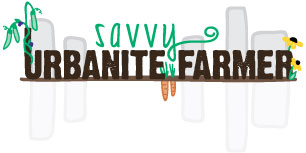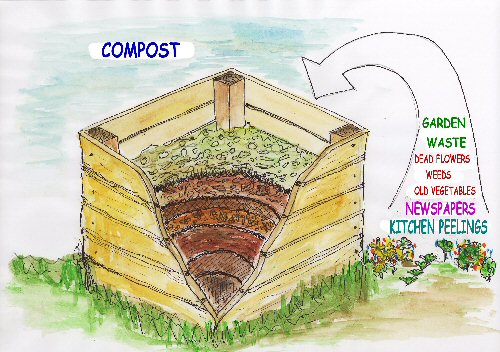Whether gardening for food, beauty, or both, compost is a gardener’s best friend. It’s an inexpensive way to add nutrients to the soil for plants, improving soil quality, and reducing waste.
Compost forms when microorganisms and bigger critters such as earthworms consume organic materials, breaking them down into a form that plants can absorb as nutrients. While compost generally doesn’t consist of more than 4 percent of any of the major plant nutrients, it helps you cut back on the amount of fertilizer you need to provide your plants or even eliminate it completely for the plants that use less nutrients, like greenery that doesn’t flower much.
Ideally, soil should consist of about 5 percent organic matter which comes from the leftovers from decomposed plant and animal material. Compost fulfils this requirement while adding the bonus of improving soil structure.Compost helps the soil hold together, making it easier for the soil to hold moisture. On the other hand, air pockets between individual grains of soil keep roots aerated and compost increases this aeration with the occasional larger chunk of this or that. This means that compost helps keep the nutrients in the soil rather than letting them wash away with each watering, while also making sure that plant roots are drowning.
Beyond that, compost boosts the populations of beneficial microbes in the soil that crowd out those that cause diseases.It really can’t get better for your plants than this.
Except it can get better for the planet. Compost helps reduce the waste that you throw into a landfill, making it one of the easiest ways you can contribute to the health of the planet while getting more than just a little satisfaction. You can take your food scraps, junk mail, office paper, coffee grounds and teabags, cotton and wool rags, pet hair, lawn clippings and autumn leaves, sticks, and more can go straight into a compost heap instead of the landfill.
Besides, no one really likes to take out the trash every couple days.
As you can see, compost is a cornerstone to a great garden of any size from a tiny patio to acres of commercial agriculture. The best thing about compost is that it is really easy to make.
How to make compost
First, you’ll need a bin if you want to keep your heap nice and tidy. You can either buy one or make something out of scrap wood. It’s often easy to find someone throwing away old shipping pallets, if the DIY route is your choice, making it easy to recycle even the wood for a new purpose. All you have to do is construct a box with open slats in the side so the air can get in.
The slideshow below are products that people have recommended to me in the past or said they have used. I, personally, have always used the small box and heap method whenever I could.
Next, though, is the fun part: starting it.
Start off your compost heap by layering a few inches of sticks or logs on bare earth. This helps the air circulate through the heap for better breakdown. If you start it on grass like I did, it won’t hurt the compost any, but it will kill the grass over time. Then, add the compost in alternating dry-wet layers for the most efficient breakdown of material. Wet is pretty much anything from your kitchen, while dry materials are often leaves, straw, and sawdust. If you have a fireplace, you can add wood ashes in, but be careful to add in thin layers so it doesn’t clump or slow down it’s own degrading process.
Tips to get the most of your compost:
- Add manure which is not only a rich source of nitrogen, but also speeds along the degradation and composting process.
- Keep the compost moist to help things along. Too much moisture will waste away important nutrients and slow the composting process, so an occasional watering should do the trick.
- Cover to help retain moisture and heat, both of which help microbes do their job faster.
- Turn every few weeks to aerate the pile which helps the microbes thrive and the compost break down faster.
After you’ve established a healthy compost heap, you can add scraps by mixing them in, rather than adding in layers, which helps aerate as you go.
What should you throw in?
While the short answer to this is “just about anything that decomposes”, there are a few things to note. First off, certain things degrade and decompose faster, so you will have to be patient and take care to turn your compost pile occasionally to get the most use of every piece of trash you throw in the bin.
Second is nutrients. For each item you throw in, there are nutrient contents to it that the soil critters will break down for your plants to use. This table are a few things that are commonly thrown away and their nutrient contents.
|
Material
|
Carbon/Nitrogen
|
Info
|
| table scraps |
Nitrogen
|
add with dry carbon items |
| fruit & vegetable scraps |
Nitrogen
|
add with dry carbon items |
| eggshells |
neutral
|
best when crushed |
| leaves |
Carbon
|
leaves break down faster when shredded |
| grass clippings |
Nitrogen
|
add in thin layers so they don’t mat into clumps |
| garden plants |
—
|
use disease-free plants only |
| lawn & garden weeds |
Nitrogen
|
only use weeds which have not gone to seed |
| shrub prunings |
Carbon
|
woody prunings are slow to break down |
| straw or hay |
Carbon
|
straw is best; hay (with seeds) is less ideal |
| green comfrey leaves |
Nitrogen
|
excellent compost ‘activator’ |
| pine needles |
Carbon
|
acidic; use in moderate amounts |
| flowers, cuttings |
Nitrogen
|
chop up any long woody stems |
| seaweed and kelp |
Nitrogen
|
apply in thin layers; good source for trace minerals |
| wood ash |
Carbon
|
only use ash from clean materials; sprinkle lightly |
| chicken manure |
Nitrogen
|
excellent compost ‘activator’ |
| coffee grounds |
Nitrogen
|
filters may also be included |
| tea leaves |
Nitrogen
|
loose or in bags |
| newspaper |
Carbon
|
avoid using glossy paper and colored inks |
| shredded paper |
Carbon
|
avoid using glossy paper and colored inks |
| cardboard |
Carbon
|
shred material to avoid matting |
| corn cobs, stalks |
Carbon
|
slow to decompose; best if chopped up |
| dryer lint |
Carbon
|
best if from natural fibers |
| sawdust pellets |
Carbon
|
high carbon levels; add in layers to avoid clumping |
| wood chips / pellets |
Carbon
|
high carbon levels; use sparingly |


